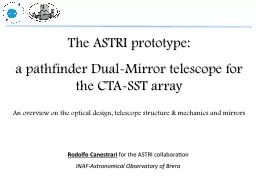

pathfinder DualMirror telescope for the CTASST array Rodolfo Canestrari for the ASTRI collaboration INAF Astronomical Observatory of Brera An overview on the optical design telescope structure amp ID: 784895
Download The PPT/PDF document "The ASTRI prototype: a" is the property of its rightful owner. Permission is granted to download and print the materials on this web site for personal, non-commercial use only, and to display it on your personal computer provided you do not modify the materials and that you retain all copyright notices contained in the materials. By downloading content from our website, you accept the terms of this agreement.
Slide1
The ASTRI prototype:a pathfinder Dual-Mirror telescope for the CTA-SST array
Rodolfo Canestrari for the ASTRI collaborationINAF-Astronomical Observatory of Brera
An overview on the optical design, telescope structure &
mechanics and mirrors
Slide2This work has been performed
by INAF in collaboration with:
Slide3The optical designF#: 0.5f
: 2.15 mPixel: 0.16°FoV: 9.6°Plate-scale: 37.5 mm/°PSF: EE80% < 6 mmEffective area: 6.5 m2
3 m
1.8 m
4.3 m
M1 radius: 8.2 m
M2 radius: 2.2 m
DET
radius: 1
m
Slide4The telescope
ItemMass [kg]M1 dish4.000Mirrors and supports555M2 dish550M2 mirror200Camera
50
Mast
560
Ballast structure
800
Counterweight
4.400
Fork and tower
4.000
Total
15.115
Preliminary mass budget
Slide5The quadrupodThe quadrupode legs with the radial bracing counteract the lateral deformations while the central tube increase the torsional stiffness.
Structural analyses
Slide61st natural frequency: 8.5 HzThe dish – RIBBED PLATE400 mm thick steel plate composed of two halves. Easy
manufacturing and assembly. Structural analyses
Slide7Sensitive analyses to understand the thermo-elastic behavior:±1°C linear gradient along dish thickness±1°C linear gradient along tower±1°C linear gradients along central tube±1°C linear gradients along mast
Important contribution to mirrors misalignmentSignificant contribution to telescope pointing
Negligible overall effects
Negligible overall effects
1
2
3
4
Structural analyses
Slide8Mechanicals systems - driving
The azimuth assembly is composed by two ball bearings axially preloaded.The driving system is done with two pinions coupled with a rim gear.The elevation assembly is composed by two shafts with preloaded tapered roller bearings.The driving system is done with a linear actuator with a gear box and preloaded ball screw.
Slide9Mechanicals systems - measuring and safety
Absolute encoders (HEIDENHAIN RON 786) interfaced with GALIL controller (with adjustable PID parameters)
Safety system concept
Electromechanical stow pins
0°
-270°
-275°
+270°
+275°
altitude
azimuth
Slide10Primary mirror (M1)
18 hexagonal shaped mirrors (11.2 m2)850 mm face-to-face, 1 m diagonal3 types of segments2 actuators + 1 fixed pointSecondary mirror (M2)1 monolithic mirror, 1.8 m diameter (2.5 m2
)
3 actuators +
3 lateral constrains
Reimaging system (CAM)
500 a-
symmetric pyramids
,
14x14x2.5 mm
3
Coatings
CAM
The optical surfaces
Slide11The optical surfaces - support and alignment
2 actuators designed to minimize the cost:Eccentric shaftEncoderStepper motorGear boxMounting/dis-mounting safe procedure
Primary mirror segments
Slide12Secondary mirror (monolithic)3 actuators connected to the mirror with load spreader (whiffletree)
3 lateral constrains support the lateral component of the mirror’s weight (varying with the elevation)
The optical surfaces -
support and alignment
Slide13Example of M1 segments alignment procedureTake a picture of the starMove one M1 segment of a known amountTake a picture of the starSubtract the two images in a “smart Conconi
way”(See the picture on the side)Find the barycenterRepeat for each segmentThe optical surfaces - support and alignment
Slide14Manufacturing process
: “Cold slumping 2.0”: hot pre-shaping + coldStructural implementation: sandwich panel with thin glass skins The optical surfaces - mirrors
Slide15The mirror design is being evaluated by very detailed FEA
Mirror’s edgeMirror’s interfacesThe optical surfaces - mirrors
Slide16Panels Results
Radius of Curvature 32 ± 0.1 m
Surface accuracy
80% energy in < 0.5
mrad
Reflectivity
> 80% range 300 to 600nm
Coating
Al + SiO
2
20 mirrors panels have been successfully produced in less then 1 month (Dec 2011)
The optical surfaces -
mirrors
All mirrors have been measured with 2f method
D90 < 1
mrad
Now, under repetition after the coating
Cold slumping technology
Weight: 11.75 kg
Slide17Some preliminary results coming from previous developments with FLABEG:
Microroughness has been measured:[5.2mm÷100mm] s = 1.6 nm rms[600÷10] mm s = 0.4 nm rms
Very good performances on spherical profiles, 300 mm scan length.
PV error
wrt
best sphere = 6
m
m
Capability of very short radii (down to 1.5 m
)
The optical surfaces -
mirrors
Hot slumping technology
Slide18R
oC 5 m
20 mm
14 mm
The optical surfaces -
mirrors
530 x 530 mm mirror segment, 5 m
RoC
assembled with standard Al honeycomb is possible.
Standard honeycomb cut in proper way to accommodate the curvature, but astigmatic deformations may occur.
Special honeycomb under evaluation to minimize deformations.
Cold slumping 2.0 technology
Slide19The optical surfaces - mirrorsBended glass from
FLABEG has been realized. The delivery is foreseen in these days.Design of the master for the mirror integration ready.Offer for “special honeycomb” obtained. It is done upon purchase order 11 weeks for the delivery!!
Slide202 sets of engineering models delivered on December 2011.12 pyramids with only 2 surfaces polished15+ pyramids with all 6 surfaces polishedMaterial: glass BK71st set of engineering models for measurement tests delivered on January 2012.
All 6 surfaces polished!Material: glass LAKN9The optical surfaces - light guides
Slide21Enhanced reflectivity for M12 layers: Al + SiO23 layers: Al + SiO2
+ ZrO25 layers: Al + 2(SiO2 + TiO2)31 layers: 15(TiO2 + SiO2) + TiO2
The optical surfaces -
coatings
Simulated reflection
Slide22Anti-reflection for light guides: 4 layers: 2(ZrO2 + SiO2)
The optical surfaces - coatingsHandling tool for depositionSimulated transmittance